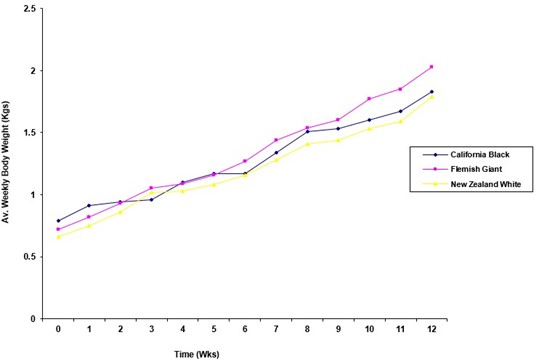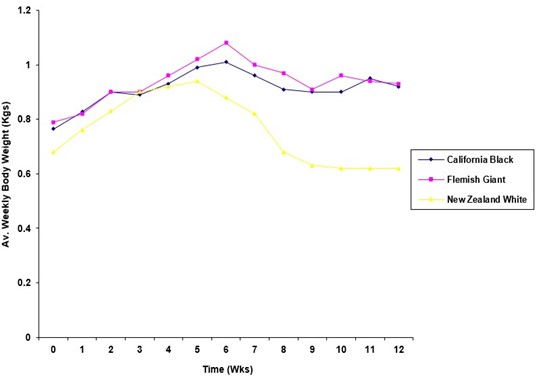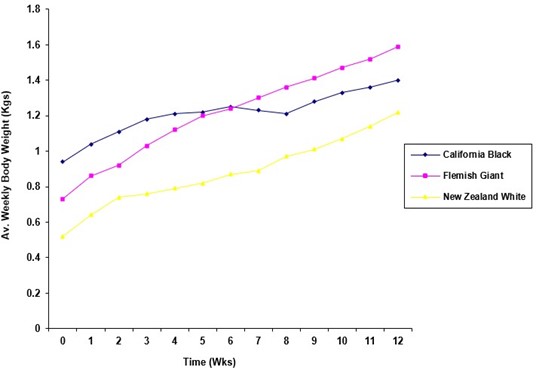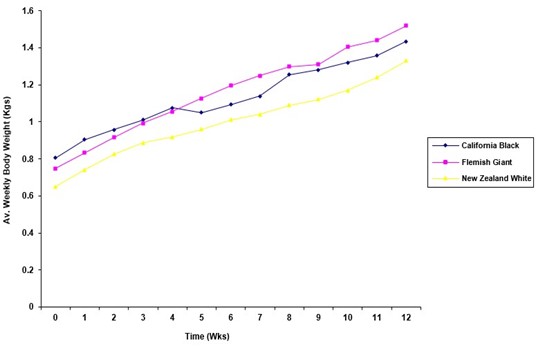Journal of Veterinary Medicine And Science
OPEN ACCESS | Volume 3 - Issue 1 - 2026
ISSN No: 3065-7075 | Journal DOI: 10.61148/3065-7075/JVMS
1 Southern University, P. O Box 60293, Livingstone, Zambia.
2 Department of Animal Science, Bunda College of Agriculture, University of Malawi, P.O Box 219, Lilongwe, Malawi.
*Corresponding author: Chisowa DM, Southern University, P. O Box 60293, Livingstone, Zambia.
Received: July 28, 2024
Accepted: August 30, 2024
Published: September 13, 2024
Citation: Chisowa DM, Mtimuni JP, Phoya RKD, Chagunda MGG. (2024) “Comparative Evaluation of Performance of Flemish Giant, New Zealand White and California Black Growing Rabbit Breeds Fed Soya Bean (Glycine Max), Cowpea (Vigna Unguiculata) and Pigeon Pea (Cajanus Cajan).” Journal of Veterinary Medicine And Science, 1(1); DOI: 10.61148/JVMS/004
Copyright: © 2024 Chisowa DM. This is an open access article distributed under the Creative Commons Attribution License, which permits unrestricted use, distribution, and reproduction in any medium, provided the original work is properly cited.
Performance of three (3) rabbit breeds [Flemish Giant (FG), New Zealand White (NZW) and California Black (CB)] raised under similar conditions was compared. Responses of the three (3) breeds to pigeon pea (PP), cowpea (CoP) and soya bean (SB) as sources of protein for growing rabbits were determined. FG, CB and NZW were fed on SB (Glycine max), PP (Cajunus cajan) and CoP (Vigna unguiculata) as protein sources in the ration. Eighteen (18) rabbits weaned at six (6) weeks of age were used for each breed (a total of fifty-four (54) rabbits) out of which six (6) of them were assigned to Ration 1 (containing 31.6 % SB), six (6) rabbits to ration 2 (containing 72 % CoP) and the last six (6) to Ration 3 (containing 70.18 % PP). The rabbits were randomly assigned to fifty-four (54) cages in a 3 x 3 factorial experiment. The three (3) legume grains were roasted before rations were compounded. Raw Legume Grains (RaLG), Roasted Legume Grains (RoLG) and the three (3) Rations (1, 2 and 3) were analysed for tannin content (TC). TC was significantly (p<0.05) higher in CoP and Ration 3. Average daily feed intake (ADFI) was significantly (p<0.05) higher for FG. Dressing-out percentage was significantly (p<0.05) higher for the FG than for either NZW or CB. The study revealed that FG was a superior breed to either NZW or CB.
Introduction
Among the many reasons for the shortage of animal protein in the SADC region is too much dependence on large animal species such as cattle. Small animal species such as poultry and rabbits are given little attention and have contributed little towards human nutrition. It is these underutilized species that have the highest potential in improving nutrition in developing countries because they fall within the investment level of the rural poor. Mainframes, such as cattle, cannot solve the widespread shortage of meat because they require too much space and are expensive for the landless and the poor; mini frames, such as small ruminants, could play an increasing role (Vietmeyer, 1985) [1].
Ninety (90) percent of the world’s population increase takes place in countries that are least able to feed themselves (UNDP, 2000) [2]. Applied research must be conducted in developing countries on all aspects of rabbit production, breeding and genetics, disease control, economics, housing systems, management, nutrition and reproduction before sound, general or specific recommendations are made (FAO, 1993) [3].
Biodiversity will always remain the source of human nutrition, particularly if the genetic diversity available in nature is widely surveyed and exploited sustainably. The most promising species and breeds for each environment must be identified through research and then promoted for human utilization. As the human population continues to increase, so does the need for increased food resource base. Livestock production has the highest potential in meeting the ever-increasing demand for human nutrition. Micro-livestock which fall within the investment level of the poorest of the poor have the highest potential for utilization as protein source among all species of livestock. Even within a given species of livestock lies a great need for the identification and promotion of breeds that have the highest potential. This evaluation may be in the form of growth-rate, prolificacy, survivability and feed efficiency. The different breeds of animals respond differently under similar management systems. The environment that favors one breed may not be the best for another. Genetic by environmental interaction plays a critical role in the performance of livestock species and breeds. Full expression of inherent genetic potential is only achieved when the environment is favorable.
The purpose of the study was to evaluate the potential of different breeds of rabbits as alternative sources of protein for human nutrition. The study was specifically designed to:
To compare Flemish Giant, New Zealand White and California Black pure-bred rabbits under a similar management system.
Materials and Methods
Study site
The study was conducted at Bunda College of Agriculture in Malawi from February 2001 to February 2002. The study area was located between 14 o 11‘S latitude and 33 o 46‘ E longitude. The area lay 1100 m above sea level.
Animals and diets
Three (3) pure bred rabbits, Oryctolagus cunniculus (Flemish Giant, California Black and New Zealand White) were used in the study. Twenty-four (24) does and six (6) bucks were estimated to breed the 54 weaners (18 of each breed) required for the experiment. The kits were weaned at 6 weeks of age. The 54 weaners with an average weight of 0.761 kg selected for fattening were identified using ear tattoos. The difference in age between the youngest and the oldest kits was 2 weeks. The average litter size was four kits per doe. The 54 weaners (18 of each breed) were offered the test rations namely: soya bean, pigeon pea and cowpea. The three (3) test rations of soya beans, pigeon peas and cowpeas were identified with numbers 1, 2 and 3 respectively. Six (6) weaners of each breed were randomly allocated to each of the three rations by picking lots. Soya bean (Glycine max), Cowpea (Vigna unguiculata), Pigeon pea (Cajanus cajan), Maize (Zea mays) and Madea (Zea mays) were used as the major feed ingredients for this experiment. Ocepara, V418 and Royes were the varieties of Soya bean, Cowpea and Pigeon pea used in the study, respectively. The major protein sources in the rations were roasted prior to grinding and mixing to reduce trypsin inhibitor. The trypsin inhibitor in raw and roasted Soya bean, Cowpea and Pigeon pea was determined by the laboratory procedure developed by Kalade et al. (1974) [4]. The rations were formulated to meet the basic energy and nutrient requirements of growing rabbits (NRC, 1996) [5]. The rations were formulated to contain 17 % crude protein (CP) and 2500 kcal/kg of metabolizable energy (ME) using the Linear Programme with Bounds (BLP88) computer package (1987) [6].
Feeding Trial
Rabbits were weighed at the start of the feeding trial. The average weight for the 54 kits was 0.761 kg. The weaners were fed on the test feeds for 7 days so that they could adapt to the new feeds before data collection started. Each rabbit was weighed at the end of the adaptation period, and this was taken as the initial weight for the feeding period of 84 days. The three grower rations were replicated twice in the experiment. The rabbits were offered 100g of feed once daily during morning hours (07.00 hours) over a 24-hour period and the rejected feed was weighed the following morning (07.00 hours). The difference was taken as the feed consumed by each rabbit per day. Rabbits were weighed individually weekly (every Friday) to obtain weekly body weight from which average daily weight gain and weekly body weight gain were calculated. Weekly body weights were recorded until the rabbits reached the targeted average weight of 2.5 kg. Clean water and feed were provided everyday using drinkers and feeders mounted in each cage. Each rabbit was offered 7 g of Leucaena leaf meal (LLM) as a source of fiber twice a week.
Carcass Analysis
Rabbits were slaughtered and the carcasses were evaluated for quality according to the procedure described by Diestre and Kempstre (1990) [7]. The chilled carcasses were weighed and the weights recorded. The carcasses were split by sawing longitudinally down the midline from the posterior end through the anterior end. The left side of each carcass was used for selected measurements. The parameters used for evaluation were:
Statistical Analysis
Data were analysed using the General Linear Model (GLM) procedures of Statistical Analysis System (SAS, 1989) [8]. Treatment means within and between breeds were tested for differences using Least Significant Means (Montgomery, 1984) [9].
Results
Average Daily Weight gains for rabbits fed rations containing soya bean or pigeon pea were significantly higher (p<0.05) than the rabbits fed a ration containing cowpea. The average daily weight gains for rabbits fed rations containing soya bean, pigeon pea and cowpea over the 12 week experimental period were; 15.59 g/day (s.e=1.02), 14.33 g/day (s.e=1.01) and 10.69 g/day (s.e=0.98), respectively (Table 1). Across rations, average body weight gain for Flemish Giant was significantly (p<0.05) higher than the average body weight gain of either the New Zealand White or the California Black (Table 1). The Flemish Giant, New Zealand White and California Black had average daily weight gains of 14.99 g/day (s.e=1.01), 12.98 g/day (s.e=1.02) and 12.71 g/day (s.e=1.03), respectively. Across breeds, average body weight gain of rabbits fed a ration containing 31.2 % soya bean was not significantly different from that of rabbits fed a ration containing 70.18 % pigeon pea but both had significantly (p<0.05) higher average daily weight gain than rabbits fed a ration containing 72.00 % cowpea (Table 1).
Table 1: Effects of Treatment, Breed and Sex on ADG (g/day) of Rabbits
|
Source of variation n Lsmeans Stderr |
|
Treatment Soya bean 18 15.59a 1.02 Pigeon pea 18 14.33a 1.01 Cowpea 18 10.69b 0.98 Breed California Black 18 12.71a 1.03 Flemish Giant 18 14.99b 1.01 New Zealand White 18 12.68a 1.02 Sex Male 25 13.98 4.83 Female 29 13.17 4.59 |
abMeans with different superscripts are significantly different (p<0.05)
ADG=Average Daily Gain. n=number of rabbits, CV= 33.8 %
Figures 1, 2 and 3 show responses of the three (3) breeds to the three rations in terms of average weekly weight. In spite of having a higher weaning weight the California Black showed a lower average weekly body weight than the Flemish Giant during the growing period when fed a ration containing soya bean (Figure 1). The New Zealand White had the lowest average weekly body weight. Rabbits fed a ration containing cowpea showed a gradual increase in weekly body weight from week 0 to week 6. Thereafter all rabbits fed cowpea experienced a decline in weekly body weight resulting in death for 5 of them after the 10th week. The New Zealand White rabbits were observed to be more sensitive to the toxins present in the ration containing cowpea as demonstrated by the decline in weekly weight. When evaluated across feeds, the Flemish Giant had a superior average weekly body weight than either the California Black or New Zealand White (Fig. 4). The New Zealand White had the lowest average weekly body weight (Figure 4).

Figure 1: Response of three rabbit breeds to Soya bean ration

Figure 2: Response of three rabbit breeds to Cowpea ration

Figure 3: Response of three rabbit breeds to Pigeon pea ration

Figure 4: Response of three rabbit breeds on all rations
Feed Intake
The Flemish Giant had significantly (p<0.05) higher feed intake than the other two breeds (Table 2). As for the feeds, soya bean was consumed (60.3 g/day; s.e=3.02) more (p<0.05) than either pigeon pea (56.2 g/day; s.e=3.04) or cowpea (37.5 g/day; s.e=2.94). The effect of sex on feed intake was not significant.
Table 2: Effect of Treatment, Breed and Sex on VFI (g/day) of Rabbits
|
Source of variation n LS means Stderr |
|
Treatment Soya bean 18 60.3a 3.02 Pigeon pea 18 56.2b 3.04 Cowpea 18 37.5c 2.94 Breed California Black 18 49.3a 3.03 Flemish Giant 18 58.2b 2.91 New Zealand White 18 46.9c 3.01 Sex Male 25 51.9 3.36 Female 29 51.1 3.29
|
a b cMeans with different superscripts are significantly different (p<0.05)
VFI=Voluntary feed intake, CV=28.26 %, n=number of rabbits
Table 3 shows the effect of breed, sex and treatment on dressing-out percentage for the three breeds fed on diets containing soya bean, pigeon pea or cowpea. The three breeds were differed in dressing out percentage. However, the influence of sex on dressing out percentage was not significantly (p<0.05).
Table 3: Effect of Treatment, Breed and Sex on Dressing-out (%) of Rabbits
|
Source of variation n LS means Stderr |
|
Treatment Soya bean 9 59.52a 2.82 Pigeon pea 9 53.44b 2.79 Cowpea 9 46.74c 2.75 Breed California Black 9 50.02a 2.82 Flemish Giant 9 57.20b 2.77 New Zealand White 9 52.47a 2.81 Sex Male 13 53.20 2.71 Female 14 53.25 2.73 |
a bc Means with different superscripts are significantly different (p<0.05)
n=number of rabbits, CV=13.66 %
Table 4 shows the effect of breed, sex and treatment on lean proportion for the three breeds fed on diets containing soya bean, pigeon pea or cowpea. The three breeds were similar in lean proportion. However, the influence of feed type on lean proportion was significantly (p<0.05) higher for rabbits fed on cowpea and pigeon pea than for rabbits fed on soya bean.
Table 4: Effect of Treatment, Breed and Sex on Lean Proportion (%) of Rabbits
|
Source of variation n LS means Stderr |
|
Treatment Soya bean 9 81.72a 1.54 Pigeon pea 9 85.47b 1.52 Cowpea 9 86.84b 1.53 Breed California Black 9 84.27 1.54 Flemish Giant 9 85.21 1.50 New Zealand White 9 84.56 1.53 Sex Male 13 85.62 1.53 Female 14 83.94 1.51 |
a bMeans with different superscripts are significantly different (p<0.05)
CV=4.6 %, n=number of rabbits
Discussion
Growth in rabbits was more pronounced during the first 70 days (ranging from 0.30 to 2.5 kg body weight) post-weaning (Fortun-Lamothe and Gidenne, 2000) [10]. In the present study weight gains were highest for Flemish Giant across feeds. This trend is indicative of the influence of both breed. Phoya (1984) [11] reported that heavier breeds had faster growth potential than smaller breeds. Average daily weight gains for the breeds observed in the present study (11-16 g/day) are in agreement with results reported by Fortun-Lamothe and Gidenne (2000) [10] who indicated that average daily weight gains ranged from 13.2 g/day to 38.9 g/day for growing rabbits (26 to 70 days of age) depending on source of protein.
Feed intake was highly influenced by both breed. Feed intake differed highly among the three breeds. Gidenne et al. (1998) [12] reported that feed intake for growing rabbits ranged from 60 to 76.94 g per day. In experiments by Fielding (1991) [13] growing rabbits consumed 60 g of feed per day. Generally, animals eat according to their size. Larger animals will eat more feed than smaller animals of the same age (Kleiber, 1975) [14]. In the present study average daily feed intakes for Flemish Giant, California Black and New Zealand White were found to be 58.2 g/day (s.e=2.91), 49.3 g/day (s.e=3.03) and 46.9 g/day (s.e=3.01), respectively. Results of this study are in agreement with observations of Fortun-Lamothe and Gidenne (2000) [10] who reported feed intake of 60-78.1 g/day by growing rabbits of between 33-70 days of age.
In the present study there were little differences in most carcass parameters among the three breeds used. The differences between breeds or live weight groups in meat quality tended to be small, which implies a certain consistency in rabbit meat. Results of this study support results obtained by Hernandez et al. (1998) [15]. Most carcass traits used for carcass quality evaluation did not differ significantly except for fat percentage and dressing-out percentage. Total fat was observed to vary with breed, sex and feed type. Fat is a late developing tissue and its content increases with age. Fat percentage was significantly (p<0.05) higher for the Flemish Giant than for either New Zealand White or California Black. All breeds had higher but non-significant fat deposition in the abdomen and lower on the carcass. With regard to feed type, fat content was significantly (p<0.001) higher for rabbits fed soya bean than for rabbits fed either pigeon pea or cowpea. Fat percentage tended to increase with the weight of the animal and was significantly (p<0.05) higher in female rabbits. Results of the present study are in consonance with findings of Andrae et al. (2001) [16] who reported higher fat content in females (79.17g) than in males (60.23g) in New Zealand White rabbits. Rabbit meat is considered lean meat and its carcass fat percentage is much lower than pork, beef or lamb (Enser et al., 1996) [17]. Lean proportion was high, on average 84.7 % irrespective of breed or feed type, showing certain constancy in rabbit meat. This implies that rabbit meat lean percentage would be similar at different market weights and that it would not be seriously changed by selection on growth rate. Results of this study agree with results observed by Hernandez et al. (1996) [18] who reported lean proportion of 84.25 % for rabbits. Dressing-out percentage is an important economic variable in the meat market and the commercial criterion used in rabbits is a slaughter yield between 56 % and 58 % from chilled carcass (Pla et al., 1998) [19]. Results of this study support results reported by Gomez et al. (1998) [20] and Pla et al. (1998) [19] who observed dressing-out percentages ranging from 55.56 % to 59.72 % for growing rabbits.
Conclusion
Results of this study have demonstrated that the Flemish Giant performs better than the New Zealand White and the California Black under similar management system. Across feeds, the Flemish Giant showed a higher growthrate than either the Newzealand White or California Black. The study has revealed that the Flemish Giant has a significantly higher feed intake than either the Newzealand White or the California Black. The study further indicated consistency in the carcass quality among the three rabbit breeds.
Funding Statement
This work was supported by the SACCAR/GTZ sponsorship.
Acknowledgments
The author of this article is thankful to farmers of Chief Chiseka of Lilongwe in Malawi for availing their rabbitry facilities and research units used during the research. I am also grateful to rabbitry workers at the Bunda rabbitry for their assistance during the trial.
Conflict of Interest
As author I declare that there are no competing interests. There is no conflict of interest regarding the publication of this article.